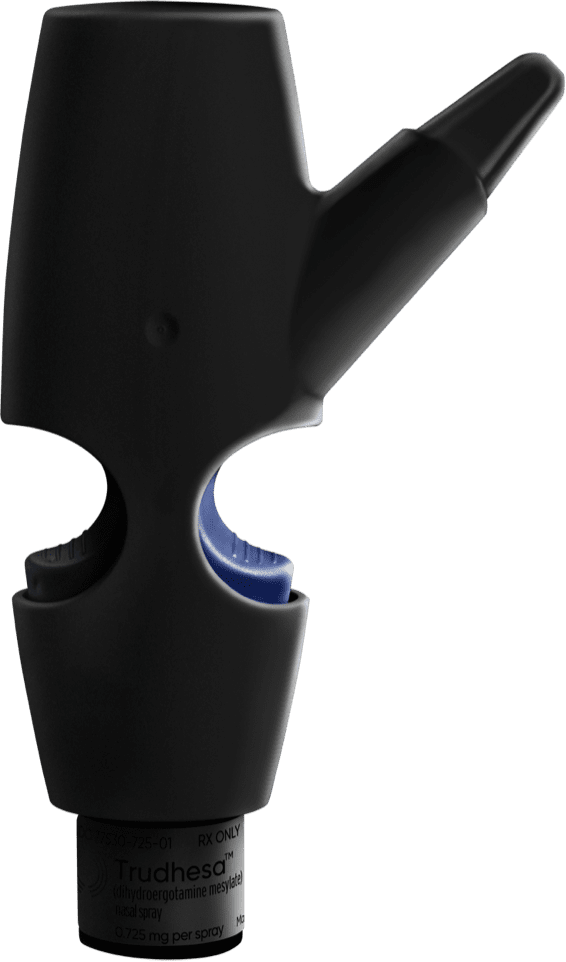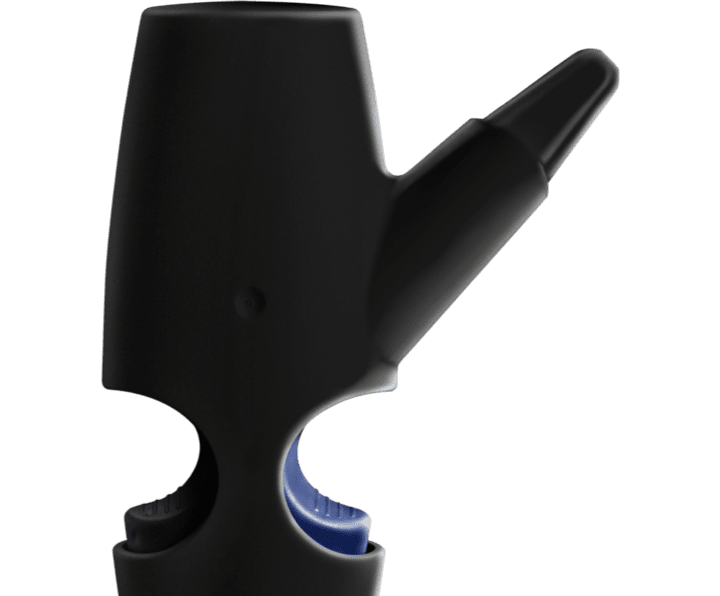Safety
Trudhesa® demonstrated a well-established safety profile in a phase 3 trial that included CV assessment¹
The Trudhesa safety study was the largest longitudinal study ever conducted with dihydroergotamine mesylate (DHE) using nasal spray delivery.¹
- Over 6300 doses of Trudhesa were self-administered over the course of the 52-week study, and only 0.6% of doses resulted in nausea2
- Nasal safety was the primary focus3
- CV effects (treatment emergent adverse events, eg, concomitant medication use, vital signs, and ECGs) were regularly collected and reviewed against preexisting conditions and concomitant medication use3


Well-established safety and
tolerability profile with DHE
The placebo-controlled studies of a traditional DHE nasal spray product
Adverse reactions reported by ≥1% of patients and more frequently than in the placebo group.
Of the 1796 patients and subjects treated with DHE nasal spray doses ≤2 mg, 26 (1.4%) discontinued because of adverse events.4
The Trudhesa safety study (N=354)
Local irritative symptoms reported by ≥1% of patients during the 6– or 12–month study.4
TRUDHESA
(N=354)
Local irritative symptoms were nasopharyngitis, rhinitis, nasal discomfort, product taste abnormal/dysgeusia, sinusitis, sinus discomfort, olfactory test abnormal, epistaxis, pharyngitis, nasal mucosal disorder, change in smell, ear discomfort, and rhinorrhea.4*
CV-related results3
Inclusion criteria:
Patients with stable hypertension and concomitant triptan use were included in the safety study.† However, concomitant use of triptans within 24 hours was disallowed. Patients were excluded if they had a history of CV events or presented with significant risk factors for CV disease.3,4
- No treatment-related cardiac events
- Minimal changes from baseline in systolic and diastolic blood pressure and median heart rate over 24 weeks
- No clinically significant ECG interpretations or TEAEs associated with an abnormal ECG
- Over 24 weeks, 1.4% (5/354) patients experienced adverse vascular events
- 0.3% of patients (1/354) experienced adverse vascular events (ie, mild hypertension) related to Trudhesa
*52% of patients experienced any local irritative symptom.4
†Patients with stable CV disease were included in clinical trials if they had no acute episodes 6 months before entering the trial.3
Efficacy

References: 1. Impel NeuroPharma announces U.S. Food & Drug administration acceptance of new drug application for INP104 for the acute treatment of migraine [press release]. Impel Pharmaceuticals; January 20, 2021. https://impelnp.com/2021/01/20/impel-neuropharma-announces-u-s-food-drug-administration-acceptance-of-new-drug-application-for-inp104-for-the-acute-treatment-of-migraine/. Accessed September 10, 2021. 2. Randle L, Aurora SK, Hocevar-Trnka J, et al. Reduced nausea when dihydroergotamine mesylate is delivered by INP104. Poster presented at: American Headache Society Virtual Annual Scientific Meeting, June 3-6, 2021. 3. Craig K, Jeleva M, Hocevar-Trnka J. Cardiovascular safety results of INP104 (POD-DHE) from the STOP 301 phase 3 study. Poster presented at: American Headache Society Virtual Annual Scientific Meeting, June 3-6, 2021. 4. Trudhesa. Prescribing information. Impel Pharmaceuticals; 2021. 5. Smith TR, Winner P, Aurora SK, Jeleva M, Hocevar-Trnka J, Shrewsbury SB. STOP 301: a phase 3, open-label study of safety, tolerability, and exploratory efficacy of INP104, Precision Olfactory Delivery (POD®) of dihydroergotamine mesylate, over 24/52 weeks in acute treatment of migraine attacks in adult patients. Headache. 2021;61(8):1214-1226.